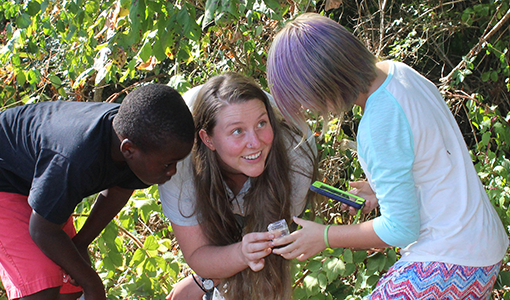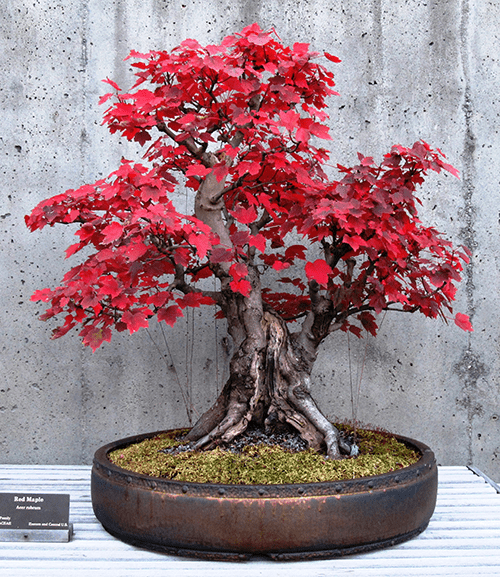
Learning and Local Economy Blossom at The North Carolina Arboretum
There’s more than one way to lose yourself at The North Carolina Arboretum in Asheville.

Its scale is grand. Under the shadow of the Blue Ridge Mountains, ten miles of trails wind through 65 acres of ornate gardens and 369 acres of woodlands. The sheer size of things makes it easy to wander well off life’s beaten path. Amazement is in store for anyone who comes. Those otherwise accustomed to shrubbery that cowers against suburban walls will be astonished by the variety of sights … from the native flame azaleas that tower overhead to the Winter Lights show, so spectacular it draws visitors from every state.
But not everything at the arboretum is on a large scale. Leaving behind familiar routines and forgetting about life’s hustle and bustle doesn’t always require vast space. The park’s micro-realms can just as easily transport busied minds into tranquil fantasy worlds. Children of all ages might find themselves slipping into fantasies of adventurous rides on the arboretum’s miniature, garden-scale model railroad or catnaps in the dewy shade of a gnarled bonsai tree.
A visit to Western North Carolina’s one of the most significant state-supported tourist attraction is so relaxing, and so intrinsically fascinating, that it’s easy to forget that the NC Arboretum is an institution that’s vital to the UNC System. Its mission isn’t just to be beautiful—it’s to advance “our state’s future by creatively connecting people, plants, and places through education, design, and education.”
That’s an ambitious goal for a garden.

In this interview, NC Arboretum’s Executive Director George Briggs (left) explains the various ways the institution is working to strengthen North Carolina. Along the way, he makes it clear that money doesn’t grow on trees. But, with ingenuity and foresight, money—and minds and the economy—can grow because of trees.
What exactly is the difference between an arboretum and a garden?
Well, the technical definition of an arboretum is simply a collection of trees.
Maybe the more relevant question is what is this arboretum. In my way of thinking, we are an economic development engine wrapped in an innovative and beautiful landscape, all nestled in a majestic region.
We have a dual personality at the arboretum. We have the “seen arboretum,” which is a visitor-based strategy that is welcoming, well-designed, and innovative. We attract 500,000 visitors a year.
And then we have the other half, which I refer to as the “unseen arboretum”: the education initiatives we’ve developed, the research and development efforts, the natural product development that we do, the work that we do to build the region’s economy around climate and climate-related business. These are the things that resonate more with state and UNC System priorities writ large.

The arboretum became part of the UNC System in 1986. Why was Asheville chosen as its location?
There was only a small, local botanical garden here in Asheville at the time. But latent in the region was a vision germinated in the 1880s and 90s by Frederick Law Olmsted and George Vanderbilt to create the world’s finest research arboretum as part of the Biltmore Estate development. Olmsted envisioned a linear space – a nine-mile road — that would host a wide array of plant life and highlight the latest research and development in species useful for the estate’s managed forestry program and the timber industry. That vision never materialized, but it stayed dormant in this area for a hundred years.
The idea for our arboretum emerged from the synergy of a number of people who had keen insight to cultivate the Olmsted vision. We had two former directors of the National Arboretum who retired to Asheville, for example. A number of local leaders were experienced in agriculture, horticulture, and landscape architecture.
In addition, economic pressure drove the thinking. North Carolina’s tobacco industry was starting to wane as an economic driver. Leaders were studying what we could do for those people in the mountains and throughout the state who depended on tobacco. The idea of an arboretum that could provide nursery stock and materials to help those farmers diversify their crops helped energize the push.
Today, we are the only public garden in America that’s part of a university system. Others are affiliated with campuses, but ours is unique in being a state-wide, university system asset.

Just plants? Or are there animals on site?
We do have animals, and they are a means to an end: youth education. We are dedicated to helping prepare students for higher education and for workforce applications. We focus on STEM education (Science, Technology, Engineering, Math). Actually, with the design and local artistry that you can find here, we really do STEAM [adding Arts] education.
What we try to do is to intervene with kids in those middle school years to help them become inspired by science, whether it’s through plants, or animals, or insects.
We have turtles, we have snakes, we have bugs … we even have people! [laughter ensues]

You just received a $1 million grant from the North Carolina GlaxoSmithKline Foundation to expand experiential K-12 education programs. You see these programs as an important contributor to the state’s quest to meet the ambitious attainment goal set by the myFutureNC Commission. Can you explain? What’s an example an arboretum initiative designed to boost STEAM education in the state?
Our impact on students is significant.
Through our youth program, Project OWL [Outdoor Wonders and Learning], we work with teachers and schools in a variety of ways. But the core of the program is direct intervention on NC’s education system. We work with pre-service teachers at Western Carolina University and at Appalachian State to prepare them to teach outdoors. And we work with in-service teachers to expand their certifications … to help them become even better teachers.
These programs have expanded well beyond Asheville. Now we have teacher training systems in 23 counties. The grant will allow us to expand these efforts into all 100 counties in the state.
We also work informally in education outside the classroom through our ecoEXPLORE program, inspiring students to develop the desire to go outside and the ability to learn outside. We help them discover how to interface with science and scientists. We encourage them to be involved with citizen science, which is essentially the process of enlisting volunteers to help professional scientists gather data and information. Bird counting is a good example.
When kids come to the arboretum, they encounter acres and acres of majestic landscape and forest, both cultivated and natural. We have a trout stream running right through the middle of our property. When they come here, they engage directly with the landscape, whether it’s designed and cultivated, or natural woodlands, wetlands, or stream ecologies. They become hands on.
In part, we’re trying to recreate something that I took for granted as a kid. When I was young, I was outdoors all the time. These days, for a variety of reasons, that’s not so much the case. But we can use new technologies and new motivations to inspire kids in ways that wouldn’t have been imaginable when I was their age. By using smart technologies, kids can find and identify species. We turn science into a game, where they earn points and gain prizes. We’re finding ways to motivate children that are relevant to them.
It’s clear that the arboretum is an asset to North Carolinians, but does your impact reach beyond the state?
Shortly after I arrived in 1987, we started cultivating enough partnerships in other states to attract North American conferences and symposiums. We leveraged that energy, and in 2000, we hosted the first ever World Congress of Botanical Gardens. We had a thousand delegates from all over the world; we hosted about 30 international associations; and we ratified the International Agenda for Botanic Gardens in Conservation, which provides a policy framework for promoting and managing conservation and biodiversity through public gardens. This guiding document has been adopted by 500 gardens worldwide.
More recently, our work has focused a lot on helping other countries develop horticultural resources and natural products. We do research and development, we do product formulation and testing, we consult with foreign companies to help them work through FDA processes to get their products to market here.

How does that work benefit North Carolinians?
Here’s one example. We have been working closely with a scientist and business leader from South Korea, Dr. Hyonho Baek, who has garnered about 50 patents. He’s so impressed by our work, by our Bent Creek Institute and by Asheville more broadly, that he actually moved here with his family.
Currently, he’s collaborating with high-quality nutraceutical companies and other scientists in South Korea and other countries, researching and developing brain-health and other products. Some of these companies have expressed interest in expanding their research capacity into North Carolina, and our long-term goal is to have companies open research and development facilities here in the greater Asheville area or elsewhere in NC. That would mean jobs and tax revenue injected into the regional and state economy.
One of the challenges of working with botanicals is getting a product into production. How do you transform an idea into a high quality product? How do handle the plant improvement and the cultivation of a former woodland botanical? How do you balance economic and sustainability issues to get the product into the supply chain? Those are the questions we help answer, along with the assistance of other UNC System entities.
So even when our work is with a foreign country, everything we do is about converting the use of botanicals in nutraceuticals into a true sector that will grow the mountain and the state’s long term economy.

We have more and more companies wanting to work with us in this space. We’ve had our hand in a wide variety of products: tea, prostate health, equine and veterinary products, CBD. We’ve helped a North Carolina company develop a botanically based omega-3 oil that is now well established in the market. This product puts a vital health supplement that had previously been almost solely fish based into the hands of vegetarians and consumers who are concerned about overfished waters.
We’ve dedicated ourselves to natural product development for about 20 years, thinking, ‘If Salt Lake City can transform themselves into a natural product center with their limited plant diversity, what can we do here in the center of the extraordinarily diverse Southern Appalachians?’
I like to think of arboretums as extroverted institutions. Many assume that arboretums are introverted places, discrete sites where people come and get what they want out of them. But we’re taking a broader approach. We are distributing our knowledge and resources throughout the state and beyond. For example, we have invested in two traveling exhibits that have now been on display in thirteen states. We have a phenomenal mountain setting, but our mindset is, how do we utilize the complexity and potential of horticulture and landscape architecture and public gardens to the benefit of North Carolina’s overall economy.
You seem really passionate about that aspect of your mission.
I grew up in North Carolina when the state was experiencing an economic shakeup. My father worked in tobacco and my mother was in furniture, so I watched over the years as what had been their livelihoods dried up. Other friends worked in textiles–same story.
Seeing all that happen first hand has certainly shaped my vision. When I came here I thought about the potential impact this new facility in the heart of the University System could have on a state that’s struggling economically. Why would we not be thinking about economic development as a major thrust of what we’re trying to do, especially as biology and biotech were becoming leading edges of science?
You’ve got a lot to entice readers to come up for visit. But, if push came to shove, what’s one thing that should lure them up in the summer? What’s your personal highlight for the season?
I’d say our annual and perennial displays, featuring a symphony of colorful native and introduced plants, particularly in our signature Quilt Garden. A personal favorite among the perennials is echinacea, is beautiful in the summer and used as a medicinal year around.

What should lure them back in the Fall?
Fall would not be fall here without the color, but also without our Bonsai Expo – an event that draws thousands of visitors to learn from international authorities, see exhibits from clubs throughout the eastern seaboard, shop for specialized materials and enjoy one of the best permanent exhibits in the United States. They’re very small trees, but it’s a very big event! While here, look for the native witch hazel that flowers as fall color recedes. It’s very attractive in fall color and medicinal, too.
Winter?
I enjoy the lacebark elms that line our avenues. They have beautiful, mottled bark that peels in an interesting way and leaves a gorgeous pattern made up of orange-dotted lines. They are also a feature of our 45-night Winter Lights event!

And what is the ‘hot ticket’ in mid-April?
From a plant perspective, this would have to be the native azaleas starting into their show. Early dogwoods are coming into play. Redbuds are hitting their peak. Tulips are at their peak. Silver bells are in bloom. Another tree commonly called serviceberry is in flower, one of the early heralders of spring. Kids are also at their peak here, participating in the very popular Mountain Science Expo, part of the statewide NC Science Festival.
If you want to learn about all of the ways our state’s arboretum is strengthening North Carolina, you should read our recently published Growing the Old North State pamphlet.
If you want to truly experience the transformative power of The North Carolina Arboretum, you should come up and see firsthand.
It’s springtime. Everything is just beginning to break out, and our plants truly put on a fantastic show.